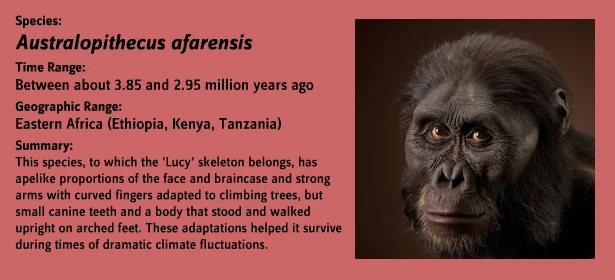The Ontogeny-Phylogeny Evolution Model[]
I believe that the adage - ontogeny recapitulates phylogeny - embodies the 'smoking gun' (e.g., in determining the ancestrally lineage of homo sapiens).
The etiology of the two abnormal foot structures that I have written about (PreClinical Clubfoot Deformity and Primus Metatarsus Supinatus foot structure ) can be easily understood when one studies the normal embryological development of the human foot.
During embryogenesis, first the fetal foot bud emerges, then it develops into the the Clubfoot Structure, then as it continues to develop, it becomes a PreClinical Clubfoot Structure, then a Primus Metatarsus Supinatus Foot Structure, and finally the Plantargrade Foot.
Using this same methodology, I believe we can trace back our homo sapien prototypes. That is, our earliest ancestors (who were bipedal obligates) would have the PreClinical Clubfoot Structure (twisted calcaneus and talar head). This would rule out A. afarensis. The A. sebida fossil's do have the twisted calcaneus (See The PreClinical Clubfoot Deformity is Almost 4 Millions Old )

Photo of A.afarensis
The above photo of A.afarensis: This preancestor did not have the twist (supinatus) in the heel bone or talar head. Following the Ontogeny-Phylogeny Evolution Model, this would rule out A.afarensis as being a human prototype.

Photo of A.sebida
The above photo of A.sebida: This hominine prototye did have the twist in the heel bone and talar head. Following the Ontogeny-Phylogeny Evolution Model, this would suggest that A.sebida was a prototype of homo sapien.
The PreClinical Clubfoot Structure/deformity forces the foot to hyperpronate. If the Laetoli footprints indicate that foot did not hyperpronate, following the above methodology, that upright walker would not be in our direct prototype, but rather a divergent line.
I believe this line of reasoning will help uncomplicate our understanding of hominine taxonomy; which is consistent with my own research. That is, the closer you get to the truth, the easier it becomes to understand.
Why Did Our Hominine Prototypes (Ancestors) Leave the Trees and Become Savanna Dwellers?[]
My evolutionary theory that our prototypes basically followed the evolutionary model - Ontogeny Recapitulates Phylogeny (See Above Post Anthropology - Tracing our Hominine Prototypes) - explains why our hominine prototypes left the trees and lived on the savanna - quite simply - the evolution of their foot structure facilitated and allowed them to do so.
That is, our earliest ancestors, who lived in the trees, had the clubfoot like foot structure. Very efficient for gasping, but totally inadequate for walking. (Just observe the gait patterns of children born with clubfoot deformities today.)
Those hominids born with the PreClinical Clubfoot Structure found walking on the ground much easier and with it all the advantages of doing so (e.g., more efficient hunter, able to traverse longer distances on the ground with less energy expenditure, etc.)
All this dovetails very nicely into the theory that the human foot evolved first (Mitchell E. 2013. Did Our Ancestors Evolve Into Human Feet First?) Accessed Online 12.06.2014 https://answersingenesis.org/human-evolution/did-our-ancestors-evolve-into-humans-feet-first/
Well, just food for thought.
Professor/Dr Brian A. Rothbart
Director of Research, International Academy RPT (http://IARPT.com)